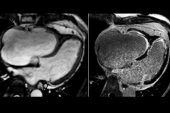Roughly Half of Patients Don’t Have Symptoms Prior to a First MI
The findings from a contemporary US cohort point to the need for better ways to identify and treat those who are at risk.

Many patients don’t have any documented symptoms or coronary artery disease risk factors in the months leading up to a first MI, but even among those who do, most aren’t taking any preventive medications, findings from a large US cohort show.
Roughly half of patients didn’t have symptoms documented 6 months prior to MI, 22.2% hadn’t seen a primary care physician and/or a cardiologist, and 63.4% were not using cardiovascular medications, lead author Nick Nurmohamed, MD, PhD (Amsterdam UMC, the Netherlands), and colleagues report.
The findings, published last week in the European Heart Journal, highlight “an unmet need for improvement of identification and adequate treatment of those at risk for myocardial infarction,” the researchers write. “These data demonstrate the urgency to shift the primarily symptom-based approach in present clinical practice to a prevention-based approach.”
That’s an important message to both physicians and the general population, senior author Deepak Bhatt, MD (Icahn School of Medicine at Mount Sinai, New York, NY), told TCTMD.
“We screen for many diseases like colon cancer and breast cancer. Probably with something where half the patients don’t even know that they’re potentially at risk for a heart attack, it’d be good to have some sort of screening as well,” he said, adding that it’s unclear what that should entail.
“But it certainly does point to the fact that if we just approach things from a secondary prevention perspective—that is, once patients have had a heart attack—that’s not a great approach,” Bhatt said. Many patients, he added, will not survive a first MI.
Commenting for TCTMD, Colin Berry, MBChB, PhD (University of Glasgow, Scotland), said the study “highlights a cause for concern, a missed opportunity,” adding that it raises questions about “what types of screening would be appropriate, proportionate, to prevent onset of MI or to delay its onset.”
Age, Sex Differences Observed
For the study, the researchers looked at data from the Clarivate Real-World Data Product, which links electronic health records, medical claims, and pharmacy claims from about 98% of government and commercial health insurance plans in the United States. The analysis included more than 4.6 million patients (median age 70 years; 42.3% women) who had a first MI between January 2017 and September 2022. About one-third (35.1%) had a STEMI.
At 6 months before the event, 18.0% of patients didn’t have any standard modifiable risk factors (SMuRFs)—including dyslipidemia, hypertension, smoking, family history of MI, diabetes, obesity, and alcohol abuse—recorded, although Bhatt noted that it’s possible some of these patients did, in fact, have risk factors that didn’t make it into the medical record.
Nonuse of cardiovascular medications was common irrespective of the presence or absence of symptoms and/or risk factors and physician visits. Among patients who had documented SMuRFs and a prior physician visit, for example, 56.0% were not taking any preventive medications. Even among those with standard risk factors, symptoms, and a prior physician visit, 52.2% were not on any cardiovascular drugs leading up to their MI.
Patients 60 years and younger as well as men were less likely than older patients and women, respectively, to have documented symptoms and SMuRFs, to have visited a physician, and to be using preventive medical therapy. Younger patients and men were more likely to have STEMI versus NSTEMI.
What Can Be Done
Though a sizeable minority of patients didn’t have any documented SMuRFs, most did have risk factors that could be addressed, and that highlights an opportunity to improve primary prevention efforts in that group, Bhatt said. Primary care physicians should be focused on identifying these modifiable risks, even among patients without physical complaints, and managing them with lifestyle changes and preventive medications according to the guidelines, he said.
“That’s something that’s tough to do in real-world practice, and this study shows that, but in terms of potential solutions, that’s a relatively low-cost, low-tech solution,” said Bhatt.
Other potential ways to address the gaps uncovered in this study still need to be investigated and there are efforts underway. Those include the TRANSFORM trial, for which Bhatt is the study chair. TRANSFORM includes asymptomatic patients with an elevated atherosclerotic CVD risk who are being randomized to usual care based on risk factors or management guided by coronary CT angiography. A variety of medical therapies will be used to tailor treatment.
Other strategies for identifying those at increased risk for MI may involve use of biomarkers or genetic screening, Bhatt indicated. Having a better way to find at-risk patients “would be really good in terms of public health,” he said.
For Berry, the study shows MI can occur even at younger ages and in individuals who don’t have any cardiovascular risk factors, which argues against “the characterization that individuals with heart attack smoke cigarettes and have high blood pressure and diabetes.”
He said that healthcare practitioners and researchers must do more to identify modifiable risk factors beyond the traditional ones, perhaps by focusing more on issues relevant to women’s health, like hypertension in pregnancy, stillbirth, and polycystic ovary syndrome, as well as genetics.
“I think we need to be thoughtful about how to be effective in screening and prevention at a population level,” Berry said, cautioning that screening interventions can sometimes have negative impacts.
Todd Neale is the Associate News Editor for TCTMD and a Senior Medical Journalist. He got his start in journalism at …
Read Full BioSources
Nurmohamed NS, Ngo-Metzger Q, Taub PR, et al. First myocardial infarction: risk factors, symptoms, and medical therapy. Eur Heart J. 2025;Epub ahead of print.
Disclosures
- The study was funded by Cleerly, which provided funding to Clarivate for the statistical analyses and paid for article processing charges.
- Nurmohamed reports receiving grants from the Dutch Heart Foundation and the European Atherosclerosis Society; receiving research funding/speaker fees from Cleerly, Daiichi Sankyo, Novartis, and Ultragenyx; and being co-founder of Lipid Tools.
- The study was funded by Cleerly, which provided funding to Clarivate for the statistical analyses and paid for article processing charges. Nurmohamed reports receiving grants from the Dutch Heart Foundation and the European Atherosclerosis Society; receiving research funding/speaker fees from Cleerly, Daiichi Sankyo, Novartis, and Ultragenyx; and being co-founder of Lipid Tools. Bhatt reports having been on advisory boards for Angiowave, Bayer, Boehringer Ingelheim, CellProthera, Cereno Scientific, E-Star Biotech, High Enroll, Janssen, Level Ex, McKinsey, Medscape Cardiology, Merck, NirvaMed, Novo Nordisk, Stasys, and Tourmaline Bio; having been on the board of directors of the American Heart Association New York City, Angiowave (stock options), Bristol Myers Squibb (stock), DRS.LINQ (stock options), and High Enroll (stock); having received consulting fees from Broadview Ventures, Corcept Therapeutics, GlaxoSmithKline, Hims, SFJ, Summa Therapeutics, and Youngene; having been on data monitoring committees with Acesion Pharma, Assistance Publique Hôpitaux de Paris, the Baim Institute for Clinical Research (formerly Harvard Clinical Research Institute, for the PORTICO trial, funded by St. Jude Medical, now Abbott), Boston Scientific (Chair, PEITHO trial), Cleveland Clinic, Contego Medical (Chair, PERFORMANCE 2), the Duke Clinical Research Institute, Mayo Clinic, Mount Sinai School of Medicine (for the ENVISAGE trial, funded by Daiichi Sankyo; for the ABILITY-DM trial, funded by Concept Medical; for ALLAY-HF, funded by Alleviant Medical), Novartis, the Population Health Research Institute, and Rutgers University (for the NIH-funded MINT trial); having received honoraria from the American College of Cardiology (Senior Associate Editor, Clinical Trials and News, ACC.org; Chair, ACC Accreditation Oversight Committee), the Arnold and Porter law firm (work related to Sanofi/Bristol Myers Squibb clopidogrel litigation), the Baim Institute for Clinical Research (AEGIS-II executive committee funded by CSL Behring), Belvoir Publications (Editor-in-Chief, Harvard Heart Letter), the Canadian Medical and Surgical Knowledge Translation Research Group (clinical trial steering committees), CSL Behring (AHA lecture), Cowen and Company, the Duke Clinical Research Institute (clinical trial steering committees, including for the PRONOUNCE trial, funded by Ferring Pharmaceuticals), HMP Global (Editor-in-Chief, Journal of Invasive Cardiology), Journal of the American College of Cardiology (Guest Editor; Associate Editor), Level Ex, Medtelligence/ReachMD (CME steering committees), MJH Life Sciences, Oakstone CME (Course Director, Comprehensive Review of Interventional Cardiology), Piper Sandler, the Population Health Research Institute (for the COMPASS operations committee, publications committee, steering committee, and USA national co-leader, funded by Bayer), WebMD (CME steering committees), and Wiley (steering committee); having been the Deputy Editor for Clinical Cardiology; being named on a patent for sotagliflozin assigned to Brigham and Women’s Hospital, who assigned to Lexicon (neither Bhatt nor Brigham and Women’s Hospital receive any income from this patent); having received research funding from Abbott, Acesion Pharma, Afimmune, Aker Biomarine, Alnylam, Amarin, Amgen, AstraZeneca, Bayer, Beren, Boehringer Ingelheim, Boston Scientific, Bristol Myers Squibb, Cardax, CellProthera, Cereno Scientific, Chiesi, CinCor, Cleerly, CSL Behring, Faraday Pharmaceuticals, Ferring Pharmaceuticals, Fractyl, Garmin, HLS Therapeutics, Idorsia, Ironwood, Ischemix, Janssen, Javelin, Lexicon, Lilly, Medtronic, Merck, Moderna, MyoKardia, NirvaMed, Novartis, Novo Nordisk, Otsuka, Owkin, Pfizer, PhaseBio, PLx Pharma, Recardio, Regeneron, Reid Hoffman Foundation, Roche, Sanofi, Stasys, Synaptic, The Medicines Company, Youngene, and 89Bio; having received royalties from Elsevier (Editor, Braunwald’s Heart Disease); and having been the site co-investigator for Cleerly.
- Berry reports being an executive editor of the European Heart Journal.





James Marshall